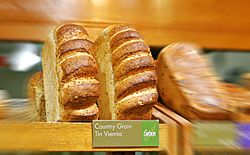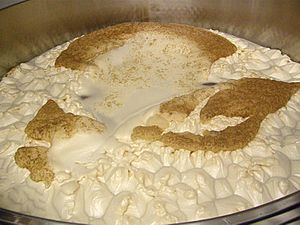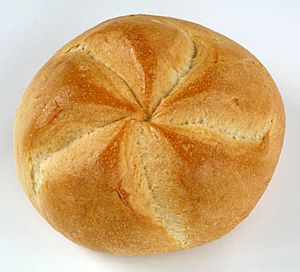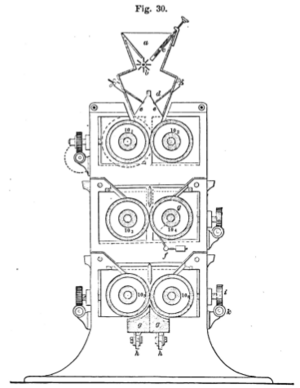Vienna bread facts for kids

"Tin" Vienna bread, an Austrian version baked in a pan rather than the traditional oval shaped loaf
|
|
| Type | Bread |
|---|---|
| Place of origin | Austria |
| Region or state | Vienna |
Vienna bread is a special kind of bread that was first made in Vienna, Austria, in the 1800s. It uses a unique way of baking. This method involves a special type of yeast and a particular way of grinding wheat from Hungary.
Contents
How Vienna Bread Was Invented
In the 1800s, something new happened in bread making. For the first time, bakers started using only beer yeast to make bread rise. Before this, they usually used a sourdough starter, which made bread a bit sour.
The first famous example of this new method was the sweet-tasting Imperial "Kaiser-Semmel". These rolls were shown at a big event called the Paris International Exposition in 1867. People loved these rolls because they weren't sour like older breads. They were very popular!
Before this, bakers would add yeast from beer to their dough. This made the bread whiter and taste sweeter.
However, there wasn't always enough beer yeast. This was because beer makers started using a different type of yeast for brewing. So, by 1846, bakers in Vienna had to find a new way to get yeast.
In 1845, Vienna bakers even held a contest to find a new way to make sweet-fermenting yeast. A person named Adolf Ignaz Mautner of Markhof won the prize in 1850. At the 1867 Paris Exposition, the Vienna Bakery was recognized as the first to use this new "press-yeast."
At the exposition, the Viennese bakery showed three types of baked goods. They had the sweet Imperial rolls, loaves made from wheat and rye, and many other fancy breads and sweet cakes. The Imperial rolls were made with fine flour, milk, water, beer yeast, and salt.
Special Yeast for Bread

The special yeast used for Vienna bread was grown using a mixture of malted corn, barley, and rye. After adding a little yeast to this cooled mixture, the yeast would grow and float to the top.
Bakers would carefully collect this yeast from the surface. They would then wash it with cool, clean water many times until only the pure yeast was left. Finally, they would press it to remove the water, making it a solid block.
This "press-yeast" was an early version of the baker's yeast we use today.
Hungarian High Milling
Another important part of Vienna bread was the way the wheat was ground. This was called "Hungarian high milling." It used a very strong type of wheat from Hungary.
The mills in Hungary used both stone grinders and new steel-roller mills. This was a very advanced way of grinding grain at the time. It was a big change from older methods that used just one pass of stone grinding. Roller milling was faster, more efficient, and kept the grain cooler.
A scientist named Eben Norton Horsford wrote about how good Hungarian wheat was. He said it had a lot of gluten and made flour that stayed fresh for a long time. The flour from Hungarian high milling was very pure, white, and high quality.
The mills in Budapest, Hungary, were very large and modern. They could grind a huge amount of wheat each year. Horsford noticed that flour made with high milling had fewer broken starch grains compared to older methods.
The idea of "high milling" actually started in Austria. A miller named Ignaz Paur was a pioneer in this method around 1810. He found that grinding the wheat multiple times, with cooling in between, made better flour. This new "cold milling" process was great for hard wheat. It likely made lighter, airier breads that rose more.
Baking with Steam
The way Vienna bread was baked also changed things. Bakers started using steam in the oven. In 1837, an Austrian named August Zang opened a bakery in Paris. He was the first to bring steam baking to France.
His method was described in a book in 1849. It said that to get a shiny crust, bakers would put wet hay on the oven floor. This would create a cloud of steam.
Later, another Viennese bakery in Paris used a mechanical steam oven. This meant they didn't need wet hay anymore. A report from the 1867 Universal Exposition described how this worked. It mentioned that the best flour from Austria and Hungary, along with the special yeast, helped make the bread excellent. The baker also used a steam oven, which was becoming very popular.
When you bake with steam, the dough goes into an oven filled with steam. This moisture keeps the crust from forming too quickly. It helps the bread rise more evenly and creates a thinner crust. The inside of the bread becomes light and airy.
Once the steam is turned off, the dry heat of the oven bakes the crust. This gives it that slightly crisp and flaky texture. Vienna bread is usually shaped like a long loaf. Some people think it might have inspired French bakers to use steam to make their baguettes.
However, not all Vienna bread was made with steam. For example, Horsford wrote in 1875 that the Vienna bakery at the Vienna Exposition used a dry oven for making rolls.
|
See also
 In Spanish: Pan de Viena para niños
In Spanish: Pan de Viena para niños



